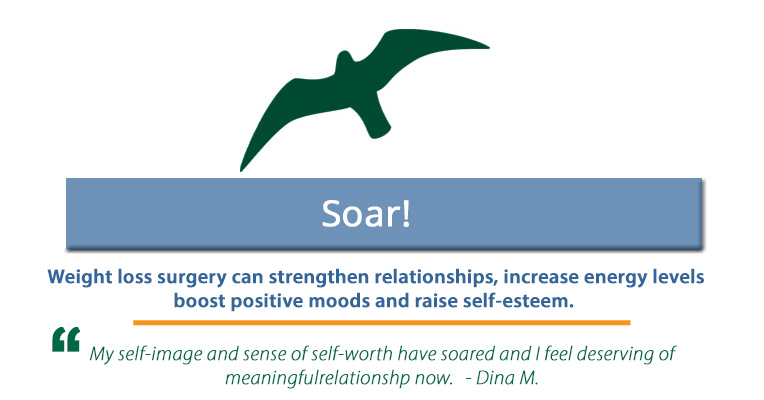Soar
Weight loss surgery can strengthen relationships, increase energy levels, boost positive moods and raise self-esteem.

Weight loss surgery can strengthen relationships, increase energy levels, boost positive moods and raise self-esteem.

How to Reach Your Goals with Bariatric Surgery
You’re ready for the health improvements that come with weight loss surgery and want to take steps to be successful. Be assured–most people lose at least half of their excess weight and, unlike non-surgical weight loss methods, keep that weight off long-term. Weight loss surgery is a great tool and putting in a little extra effort will give the best possible results. Here are 7 simple steps for maximizing weight loss surgery results.
I took control of my after-care. I knew this was a very important step for me to succeed. I journaled, read up on post-op care, and followed the healing procedures. To this day, 11 years later, I still journal when I think I need to get back on track. I still exercise on my treadmill. I told myself 11 years ago that I was going to be successful; my change was permanent. –Nora K.
Step 1 – Learn. Knowledge and skills are essential to make changes to the way you eat, think and live for best results from surgery. Barix Clinics offers many educational opportunities: follow up appointments, in-person support groups, a Facebook support group, monthly newsletters, and tips sheets.
Step 2 – Track. If specific behaviors are monitored, they are more likely to continue. It’s helpful to monitor:
Step 3 – Keep fluids calorie-free. Water, Vitamin Water Zero, Bai Water, SoBe Water, diet iced tea, Crystal Light, Mio, and sugar free Kool-Aid are good options. Sipping on higher-calorie fluids can derail your efforts.
Step 4 – Eat right. With a decreased drive to eat, it is easier to make healthy food choices. Be sure to:
Step 5 – Move more. Many people find that they have less joint pain shortly after surgery. That makes it easier to get in regular walks and eventually other exercises. The time invested in exercising pays off immediately by raising your energy level and mood.
I’m much more active now that I don’t hurt from walking and the heat doesn’t get to me. I can easily jog around my neighborhood, when before I couldn’t walk. –Terri J.
Step 6 – Manage stress and emotions. Developing new coping mechanisms will be important if you tend to cope with emotional highs and lows with food. If you’re grazing throughout the day, feeling out of control with eating, or continually making poor food choices, the help of a trained therapist may be worth investigating. Stress management techniques, such as meditation or deep breathing can also be implemented independently.
Step 7 – Manage Medical Conditions. Medical conditions and medications can be managed with your primary care physician to minimize their impact on weight loss:
We’ll be with you every step of the way, providing information and tools to reach your health and weight loss goals. Once you know the steps to take, it’s simple.